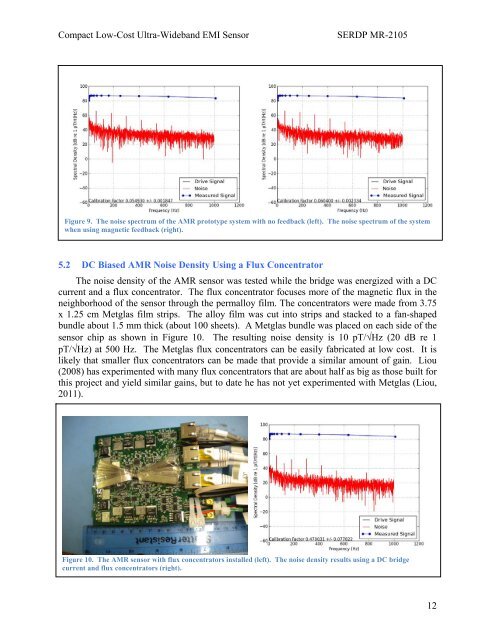Final Report - Strategic Environmental Research and Development ...
Final Report - Strategic Environmental Research and Development ...
Final Report - Strategic Environmental Research and Development ...
Create successful ePaper yourself
Turn your PDF publications into a flip-book with our unique Google optimized e-Paper software.
Compact Low-Cost Ultra-Wideb<strong>and</strong> EMI SensorSERDP MR-2105Figure 9. The noise spectrum of the AMR prototype system with no feedback (left). The noise spectrum of the systemwhen using magnetic feedback (right).5.2 DC Biased AMR Noise Density Using a Flux ConcentratorThe noise density of the AMR sensor was tested while the bridge was energized with a DCcurrent <strong>and</strong> a flux concentrator. The flux concentrator focuses more of the magnetic flux in theneighborhood of the sensor through the permalloy film. The concentrators were made from 3.75x 1.25 cm Metglas film strips. The alloy film was cut into strips <strong>and</strong> stacked to a fan-shapedbundle about 1.5 mm thick (about 100 sheets). A Metglas bundle was placed on each side of thesensor chip as shown in Figure 10. The resulting noise density is 10 pT/Hz (20 dB re 1pT/Hz) at 500 Hz. The Metglas flux concentrators can be easily fabricated at low cost. It islikely that smaller flux concentrators can be made that provide a similar amount of gain. Liou(2008) has experimented with many flux concentrators that are about half as big as those built forthis project <strong>and</strong> yield similar gains, but to date he has not yet experimented with Metglas (Liou,2011).Figure 10. The AMR sensor with flux concentrators installed (left). The noise density results using a DC bridgecurrent <strong>and</strong> flux concentrators (right).12
















